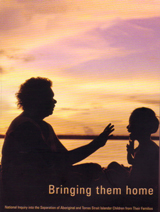
Bringing Them Home
Bringing Them Home is the 1997 Australian Report of the National Inquiry into the Separation of Aboriginal and Torres Strait Islander Children from Their Families. The report marked a pivotal moment in the controversy that has come to be known as the Stolen Generations.
Also known as
Bringing Them Home report (1997)
National Inquiry into the Separation of Aboriginal and Torres Strait Islander Children from Their Families
11 May 1995 – 26 May 1997
The inquiry was established by the federal Attorney-General, Michael Lavarch, on 11 May 1995,[2] in response to efforts made by key Indigenous agencies and communities concerned that the general public's ignorance of the history of forcible removal was hindering the recognition of the needs of its victims and their families and the provision of services.[3] The 680-page report was tabled in Federal Parliament on 26 May 1997.[4]
Background[edit]
Aboriginal organisations pushed for a national inquiry as early as 1990. The Secretariat of the National Aboriginal and Islander Child Care (SNAICC) resolved at its national conference in 1992 to demand a national inquiry. Other state Aboriginal organisations were also active during this period.
In 1992 then Prime Minister Paul Keating made his famous Redfern Park Speech in Redfern, Sydney, in which for the first time, acknowledgement was made that children were taken away from their mothers.[5]
In 1994, the Aboriginal Legal Service of Western Australia (ALSWA) began soliciting statements from Aboriginal people who had been removed from their families as children or who were parents of removed children. The service interviewed over 600 people during this time and produced a report titled Telling our Story.[6]
Commissioners[edit]
The inquiry was primarily conducted by Sir Ronald Wilson, President of the Human Rights and Equal Opportunity Commission, and Mick Dodson, the Aboriginal and Torres Strait Islander Social Justice Commissioner.[7]
Indigenous women, appointed as co-commissioners, provided support to the people who gave evidence in each region the inquiry visited. The co-commissioners were: Annette Peardon, Marjorie Thorpe, Dr Maryanne Bin Salik, Sadie Canning, Olive Knight, Kathy Mills, Anne Louis, Laurel Williams, Jackie Huggins, Josephine Ptero-David and Professor Marcia Langton. The co-commissioners also assisted in the development of the report and its recommendations.[7]
The inquiry also appointed an Indigenous Advisory Council made up of members from all the major regions of Australia. Members of the council were: Annette Peardon, Brian Butler, Yami Lester, Irene Stainton, Floyd Chermside, Barbara Cummings, Grant Dradge, Carol Kendall, Lola McNaughton, Isabel Coe, Peter Rotimah, Nigel D'Souza, Maureen Abbott, Margaret Ah Kee, Bill Lowah, Matilda House and Jim Wright.[7]
Two reports were produced:[4]
The Community Guide summarised the report's conclusions that "indigenous families and communities have endured gross violations of their human rights. These violations continue to affect indigenous people's daily lives. They were an act of genocide, aimed at wiping out indigenous families, communities, and cultures, vital to the precious and inalienable heritage of Australia".[8]
The report made many recommendations, including that:
Criticisms[edit]
The Howard government rejected some elements of the findings of the National Inquiry into the Separation of Aboriginal and Torres Strait Islander Children from Their Families, notably the recommendation for an "apology". John Herron, then Minister for Aboriginal Affairs, said "the government does not support an official national apology. Such an apology could imply that present generations are in some way responsible and accountable for the actions of earlier generations; actions that were sanctioned by the laws of the time and that were believed to be in the best interests of the children concerned".[13] Prime Minister John Howard believed that the term "apology" would suggest inter-generational guilt, and therefore left out the word "sorry" from his Motion of Reconciliation.[13]
Other criticisms centred on the evidentiary standards applied. The Inquiry had sought to provide an opportunity to discover the experiences of people removed from their families. It was anticipated that given the trauma witnesses had experienced that they would be at risk of further trauma if they were to be cross examined on their testimony and their evidence challenged.[18][19] Acting on this judgment the report, Bringing them Home, was written on the evidence presented. Among a number of criticisms of the report, also reflected in the arguments of those arguing the impact of the events described were exaggerated or minimising or denying their occurrence this "failure" to "prove the evidence" was considered critical, a number of other criticisms were made, chief among the critics were John Herron[20] and Ron Brunton.[21][22]
A number of responses, some critical, responded to the points raised Herron and Brunton.[23][24] Many of these arguments continue into the present around the formal apology to the Stolen Generations of 13 February 2008.